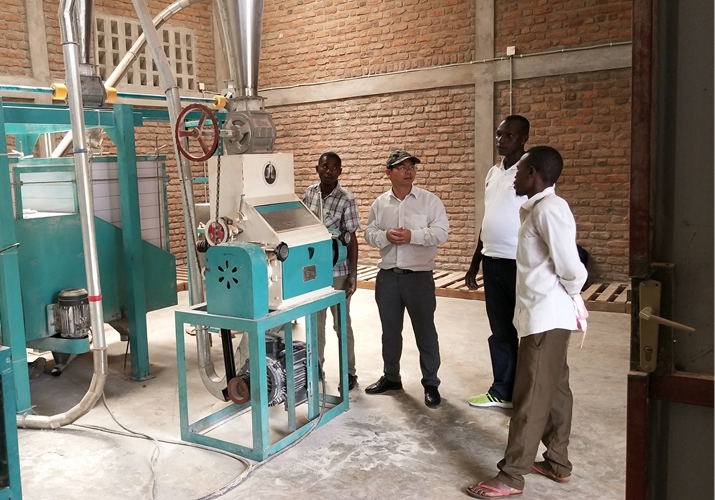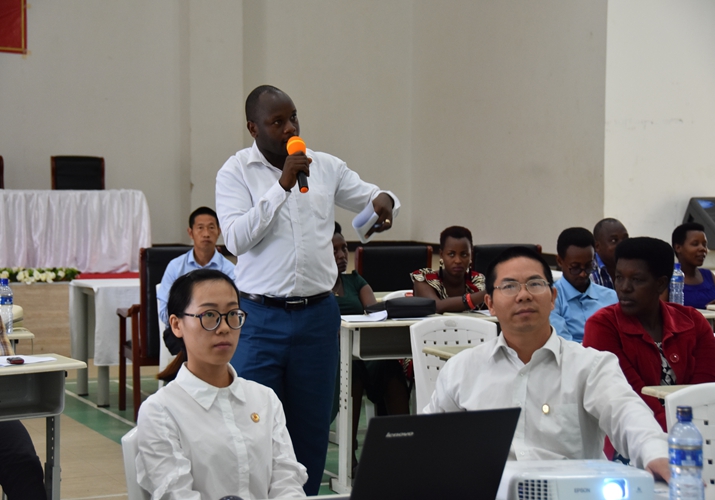
Hu Shuangquan teaches at a training class on agricultural product processing technology (COURTESY PHOTO)
On November 2, the third-generation hybrid rice developed by Yuan Longping, China's "father of hybrid rice," and his team achieved a yield of 911.7 kg per mu (0.067 hectare) in an experimental plot in central China's Hunan Province. Combined with an early-season rice yield of 619.06 kg, the total annual rice yield of the plot in Qingzhu Village, Hengnan County of the province reached 1,530.76 kg per mu.
Similar to their work at home, many Chinese agricultural experts are now working hard on the African continent, aiming to increase the crop yields, improve the level of agricultural industry development, and contribute to building a China-Africa community with a shared future. Hu Shuangquan, now aged 49, is one of them.
Two years ago, Hu worked in the Agricultural Technology Service Center of Xiaoling Township, Chongyang County in central China's Hubei Province. Now, he is in a Chinese agricultural expert group working in Burundi, where they provide technical assistance to the local people.
In this aid mission, Hu's main work is to carry out the research and technical demonstration of the production, processing and storage of agricultural products, and conduct technical training sessions.
"From 2003 to 2014, I worked in three African countries. During that period, I found that there was much to be improved in Africa in terms of agricultural production, processing and storage technology. So, after learning of this aid program, I signed up immediately and am honored to be picked out," Hu told ChinAfrica.
In March 2018, Hu set foot on the African continent again, he was determined to do his utmost to help African people with his expertise.
Hu Shuangquan guides cassava processing and production in a cassava processing plant (COURTESY PHOTO)
Raising rice yield
On January 15, Hu received a call from the technical director of the Socopa Rice Processing Plant in Gihanga County of Bubanza Province, who told him anxiously that their rice polishing machine did not work and asked him for help.
Hu immediately drove more than 30 km to get to the place, and after a careful inspection, he debugged the equipment to return it to normal. The plant completed the processing task on schedule.
Hu often came across problems such as this. "A request is a 'combat order.' I am very pleased to be of help during my tenure," Hu said.
Burundi is an agricultural country with more than 90 percent of the population engaged in agricultural production, where the mode of production is relatively underdeveloped. "The situation is similar to China's in the 1970s and 1980s. Therefore, my work experience gained back in China may serve as a practical guide for boosting agricultural development here," Hu added.
In June 2018, in order to increase rice production, Hu and his Chinese colleagues used Socopa Rice Processing Plant as an experimental demonstration site to help it build a high-quality rice brand and lead the development of Burundi's rice production.
Hu donated the rice-polishing machine used by the Chinese expert group to the factory. He also wrote a manual on quality control and processing to maintain lasting rice-processing quality.
At present, the output and profits of the factory are thriving. Its production capacity has increased from 0.3 tons per hour to 1 ton per hour, and the rice quality has been upgraded from the third-grade with the lowest market price to the top grade with the highest price. Moreover, the factory's energy consumption and labor costs have been reduced by $6 per ton, respectively, with its total rice output and sales both increasing from less than 10 tons per month to more than 36 tons per month.
At this point, Hu began to help with brand building and marketing for the factory's rice. He designed colorful packaging bags and publicity pictures, and distributed them in local residential areas and shops.
Besides, Hu actively explored the development of the industrial chain, trying to conduct more rice-processing experiments in local areas.
With the support of the National Center of Food Technology of Burundi, Hu endeavored to optimize the formula of local traditional popular fried snack. He ground rice into powder, and mixed it with flour to make the snack that meets the taste of the locals.
"We use 140 kg of flour and 60 kg of rice flour to make the snack of the same value, which reduces the cost of materials by thousands of dollars a year," Hu said, "Compared with the previous snack, this new one is better, and the production cost is lower."
Finding solutions
According to Hu, Burundi's agricultural processing machinery is mainly dependent on import, and sometimes it is difficult to repair or replace damaged parts after breakdowns. This undoubtedly increases the difficulty of his local demonstration and local agricultural development.
"I would try to get in touch with manufacturers, helping them get the parts they need. Meanwhile, I have been training local technicians to enhance their awareness of equipment maintenance," Hu noted.
In order to comprehensively learn about the current situation of Burundi's agricultural product processing industry, Hu went deep into the crop-planting areas across Burundi to conduct on-the-spot investigation and research.
He wrote seven special reports on agricultural product processing based on his work experience, and completed nearly 35,000 words of research papers on the Burundian agricultural product processing industry, creating reference materials for the development of the industry.
On the 2020 World Food Day on October 23, Burundian President Évariste Ndayishimiye made a speech speaking highly of China-Burundi agricultural cooperation.
President Ndayishimiye said that over the years, a number of friendly countries and world organizations have supported the revitalization of Burundi's agriculture. He went on to say that Burundi is especially grateful to China for actively helping Burundi's economic and social development.
Staying put
Affected by the COVID-19 pandemic, Hu, who had planned to wind up his mission in mid-March, is still staying in Burundi. "From late March to early November, Burundi closed its international borders, and fresh agricultural expert groups from China could not come to Burundi or other Africa countries as scheduled," Hu said.
In order to ensure the continuity of China's aid work, Hu and another Chinese expert stayed behind, their main task is to carry on experimental demonstration and technical training, popularize hybrid rice, and ensure a smooth handover and successful operation of the newly created Burundi Agricultural Technology Demonstration Center.
"We are staying on to make the promotion of hybrid rice experiment and demonstration more effective, to accelerate the localization process of hybrid rice seeds," Hu said. CA
(Print Edition Title: The Field of Hope)
Comments to likzh@chinafrica.cn

